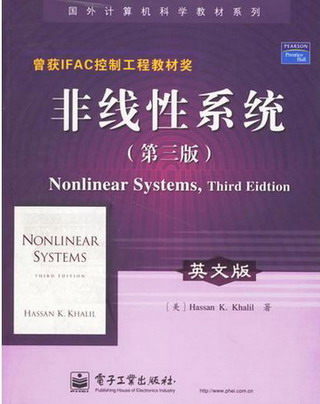作者简介:
Hassan K. Khalil,1978年于伊利诺伊大学获得博士学位,现为美国密歇根州立大学电气与计算机工程系University Distinguished教授。1989年由于其在“奇异扰动理论及其在控制中的应用”所取得的成就被选为IEEE会士。多年来一直从事非线性系统的教学和研究工作,主要研究方向包括:非线性(鲁棒和自适应)控制、奇异扰动理论和电驱动控制。本书第二版曾于2002年获国际自动控制联合会(IFAC)授予的控制工程教材奖。
内容简介:
本书是美国密歇根州立大学电气与计算机工程专业的研究生教材,全书内容按照数学知识由浅入深分成了四个部分:基本分析、反馈系统、现代分析、非线性反馈控制。基本分析部分介绍了非线性系统的基本概念和基本分析方法;反馈系统分析部分介绍了输入—输出稳定性、无源性和反馈系统的频域分析;现代分析部分介绍了现代稳定性分析的基本概念、扰动系统的稳定性、扰动理论和平均化以及奇异扰动理论;非线性反馈控制部分介绍了反馈控制的基本概念的反馈线性化,并给出了几种非线性设计工具,如滑模控制、Lyapunov再设计、反步法、基于无源的控制和高增益观测器等。此外,本书的附录还汇集了一些书中用到的数学知识,包括基本数学知识的复习、压缩映射和一些较为复杂的定理证明。
本书既可以作为研究生第一学期非线性系统课程的教材,也可以作为工程技术人员、应用数学专业人员的自学教材或参考书。
英文目录:
1 Introduction
1.1 Nonlinear Models and Nonlinear Phenomena
1.2 Examples
1.3 Exercises
2 Second-Order Systems
2.1 Qualitative Behavior of Linear Systems
2.2 Multiple Equilibria
2.3 Qualitative Behavior Near Equilibrium Points
2.4 Limit Cycles
2.5 Numerical Construction of Phase Portraits
2.6 Existence of Periodic Orbits
2.7 Bifurcation
2.8 Exercises
3 Fundamental Properties
3.1 Existence and Uniqueness
3.2 Continuous Dependence on Initial Conditions and Parameters
3.3 Differentiability of Solutions and Sensitivity Equations
3.4 Comparison Principle
3.5 Exercises
4 Lyapunov Stability
4.1 Autonomous Systems
4.2 The Invariance Principle
4.3 Linear Systems and Linearization
4.4 Comparison Functions
4.5 Nonautonomous Systems
4.6 Linear Time-Varying Systems and Linearization
4.7 Converse Theorems
4.8 Boundedness and Ultimate Boundedness
4.9 Input-to-State Stability
4.10 Exercises
5 Input-Output Stability
5.1 L Stability
5.2 L Stability of State Models
5.3 L2 Gain
5.4 Feedback Systems: The Small-Gain Theorem
5.5 Exercises
6 Passivity
6.1 Memoryless Functions
6.2 State Models
6.3 Positive Real Transfer Functions
6.4 L2 and Lyapunov Stability
6.5 Feedback Systems: Passivity Theorems
6.6 Exercises
7 Frequency Domain Analysis of Feedback Systems
7.1 Absolute Stability
7.2 The Describing Function Method
7.3 Exercises
8 Advanced Stability Analysis
8.1 The Center Manifold Theorem
8.2 Region of Attraction
8.3 Invariance-like Theorems
8.4 Stability of Periodic Solutions
8.5 Exercises
9 Stability of Perturbed Systems
9.1 Vanishing Perturbation
9.2 Nonvanishing Perturbation
9.3 Comparison Method
9.4 Continuity of Solutions on the Infinite Interval
9.5 Interconnected Systems..
9.6 Slowly Varying Systems
9.7 Exercises
10 Perturbation Theory and Averaging
10.1 The Perturbation Method
10.2 Perturbation on the Infinite Interval
10.3 Periodic Perturbation of Autonomous Systems
10.4 Averaging
10.5 Weakly Nonlinear Second-Order Oscillators
10.6 General Averaging
10.7 Exercises
11 Singular Perturbations
11.1 The Standard Singular Perturbation Model
11.2 Time-Scale Properties of the Standard Model
11.3 Singular Perturbation on the Infinite Interval
11.4 Slow and Fast Manifolds
11.5 Stability Analysis
11.6 Exercises
12 Feedback Control
12.1 Control Problems
12.2 Stabilization via Linearization
12.3 Integral Control
12.4 Integral Control via Linearization
12.5 Gain Scheduling
12.6 Exercises
13 Feedback Linearization
13.1 Motivation
13.2 Input-Output Linearization
13.3 Full-State Linearization
13.4 State Feedback Control
13.5 Exercises
14 Nonlinear Design Tools
14.1 Sliding Mode Control
14.2 Lyapunov Redesign
14.3 Backstepping
14.4 Passivity-Based Control
14.5 High-Gain Observers
14.6 Exercises
A Mathematical Review
B Contraction Mapping
C Proofs
C.1 Proof of Theorems 3.1 and 3.2
C.2 Proof of Lemma 3.4
C.3 Proof of Lemma 4.1
C.4 Proof of Lemma 4.3
C.5 Proof of Lemma 4.4
C.6 Proof of Lemma 4.5
C.7 Proof of Theorem 4.16
C.8 Proof of Theorem 4.17
C.9 Proof of Theorem 4.18
C.10 Proof of Theorem 5.4
C.11 Proof of Lemma 6.1
C.12 Proof of Lemma 612
C.13 Proof of Lemma 7.1
C.14 Proof of Theorem 7.4
C.15 Proof of Theorems 8.1 and 8.3
C.16 Proof of Lemma 8.1
C.17 Proof of Theorem 11.1
C.18 Proof of Theorem 11.2
C.19 Proof of Theorem 12.1
C.20 Proof of Theorem 12.2
C.21 Proof of Theorem 13.1
C.22 Proof of Theorem 13.2
C.23 Proof of Theorem 14.6
Note and References
Bibliography
Symbols
Index

